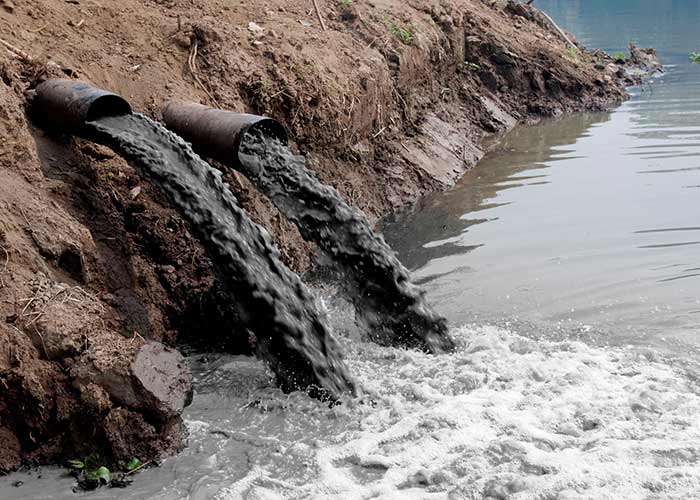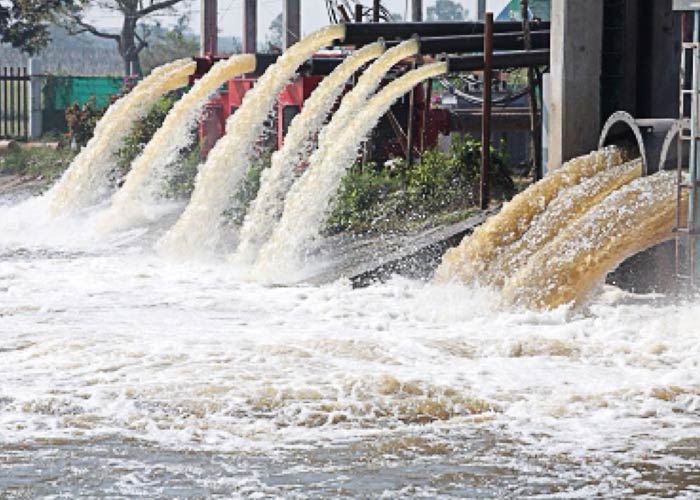Climate change has emerged as the greatest danger of the 21st century. This danger is believed to be greater than the third world war or the collision of any asteroid with the Earth. Climate Change has been manifesting itself in the form of irregularities and disturbance in the climate cycle as fallout of increase in the temperature of the Earth due to the phenomena of global warming. In the last 150-200 years, climate change has happened so rapidly that the flora and fauna of the world are finding it difficult to reconcile with this change.
Climate change has assumed the form of an international problem. Not only the developed or developing countries, but all the countries of the world are in its grip. If the solution is not found in the time, then the Earth’s future will be unimaginable. Therefore, all the nations of the world and the United Nations (UN) are seriously considering to get rid of this problem.
The serious consequences of climate change have now started to appear, and the latest example of this is that 2016 has left behind 2015 in term of heat; it has been the warmest year ever recorded. According to an analysis of the World Meteorological Organization (WMO) of the United Nations Climate Agency, the average global temperature in 2016 was 1.1 degrees Celsius above the previous period. According to WMO Secretary-General Petteri Talas, carbon dioxide and methane concentration reached a new record in 2016. According to the analysis, the level of ice in the Arctic Sea is also very low. The Arctic Ocean is rapidly getting warmer than the global average and it has constantly influenced weather, climate and oceanic circulation in other parts of the world.
What is Climate Change?
Climate is the weather condition of a region. Variations in global or regional climate patterns, wind pressure, wind, rain, etc are things that can bring about climate change. Climate change refers to the unprecedented change in climate cycles apparent from the mid to late 20th century onwards. Climate change is a historical change in the pattern of average seasonal conditions. Generally, these changes are studied by dividing the history of Earth into long periods. This change in the conditions of climate can be natural and also the result of human activities.
To explain climate change further, there has been constant change in climate over the last century due to the increase in the temperature of our Earth. Our soil gets naturally heated with the sun’s rays. The surface of the Earth where this energy reaches remains warm. Part of this energy gets reflected through the surface of the Earth and the sea and then goes back to the atmosphere. The way the Earth’s atmosphere absorbs some of the energy of the sun is called Greenhouse Effect. The Earth’s atmosphere is composed of many gases, including some greenhouse gases. There is a layer of greenhouse gases, which include carbon dioxide, methane, and nitrous oxide.
This layer absorbs most of the sun’s energy and then transmits it to the four directions of the Earth. These gases make a natural cover or layer over the Earth and protect it from more energy of the sun.
Scientists believe that because of the increasing industrial and agriculture activities, more gases are being released in the atmosphere and this layer of greenhouse gases that absorb part of the sun’s energy is getting thicker. As this cover becomes even thicker, it absorbs excess rays of the sun which do not go back to ‘space.’ Thus, the cover is absorbing more energy and is increasing the temperature of the Earth. These phenomena of global warming leads to climate change.
Global Climate Change or World Climate Change
Scientists have found that since the industrial revolution, the amount of carbon dioxide and greenhouse gases in the atmosphere is greatly increasing. In the last 100 years, the world’s temperature has increased by at least 0.85 degree Celsius (1.53 degrees Fahrenheit). Not only this, during this time sea level also increased by 20 centimetres (8 inches).
The Earth’s climate is changing alarmingly. Tremendous changes have been seen in natural phenomena over the years. For example, snowfall in the northern hemisphere, melting of ice in the Arctic Ocean, and melting of glaciers unseasonal rains and volcanic eruptions across all continents.
Presently, the Earth is getting hotter three times faster than in the 1970s. Human activities leading to more emissions of greenhouse gases are mainly behind this growing global heat. Machines such as air conditioners, refrigerators, ovens etc. play a major role in enhancing this heat. According to scientists, if the emission of greenhouse gases continues, the temperature of the Earth could rise by 3 to 8 degrees in the 21st century. If this happens then the results will be very disastrous. The ice sheets in many parts of the world will be melted; sea levels will increase up to several feet above. With this behaviour of sea, many parts of the world will be submerged. Heavy devastation will take place.
Climate change information and facts
Climate change has a very negative effect on Planet Earth. Since the 19th century, the overall temperature of the Earth’s surface has enormously increased. The sea temperature has increased to 3,000 meters (about 9,800 feet) deep.
In the northern and southern hemispheres, there is a decrease in glacier and snow covered areas due to which the water level of the sea has increased. With the rise in sea level, increase in heat, and melting of glaciers, there has been drastic change in the climate.
For the past 100 years, the average temperature of Antarctica is rising by double the temperature of the Earth’s average. In Antarctica, the snow-covered area has decreased by 7 percent, while the seasonal decrease has increased to 15 percent.
Rains are rising in some parts of North America, parts of northern Europe and parts of northern Asia, while the drought trend in the Mediterranean and South Africa is on the rise. The western winds are becoming very strong.
Critical changes are taking place in the highest temperature – hot winds and hot days are getting much more visible, while cold days and cold nights have become very less.
The increase in the temperature of the surface of the Atlantic Ocean has led to the intensity of several storms; however, there is no increase in the number of tropical storms.
Reasons and Causes of Climate Change
Tremendous changes have been seen in natural climate over the years. Causes of this can be divided into two parts — natural and man made
- Natural causes
Many natural causes are responsible for climate change such as shifting of continents, volcanoes, sea waves and earth rotation.
- Continental Drift
The continents that we are seeing today were formed with the origin of this planet and they rest on massive slabs of rock called tectonic plates which are always moving. This type of movement produces waves and air flow in the ocean. It causes changes in the climate. Thus the shifting of the continents continues to this day.
- Volcanic Eruption
Whenever a volcano erupts, it emits sulphur dioxide, water, dust and ash particles in the atmosphere in large amounts. Although the volcano works for a few days only, but during this time, the excessive amount of gases can affect the climate for a long time. The gas and dust particles block the path of the sun’s rays, resulting in natural imbalance.
- Earth’s Tilt
Earth is tilted in its orbit at an angle of 23.5 degrees. Changes in this inclination lead to changes in the order of the weather. More leaning means more heat and winter and less leaning mean less heat and general cold.
- Sea Waves
The sea is a major part of the climate. It is spread over 71% area of the Earth. Sun rays are absorbed by the sea at twice the rate of Earth’s surface. Through the sea waves, heat is spread in large quantities to the entire planet.
- Human reasons
- Greenhouse Gases
Greenhouse gases like carbon dioxide, methane and nitrous oxide are mainly responsible for climate change. Of them, the highest emission belongs to carbon dioxide.
Power plants use large amounts of fossil fuels (e.g. coal) to generate electricity. All this produces a large amount of carbon dioxide. It is believed that 20 percent of the world’s carbon dioxide is emitted due to the petrol engine engaged in vehicles. Apart from this, homes in developed countries emit more carbon dioxide than any car or truck. The amount of carbon dioxide emitted in making them is too much. Apart from this, equipment used in these houses also emits these gases.
Carbon dioxide is formed when we burn any kind of fuel like coal, oil, natural gas etc. As we are also destroying the trees, the carbon dioxide accumulated in the trees is also released in the environment. Due to increase in farming, diversity in land use and many other sources, there is more secretion of gases like methane and nitrous oxide into atmosphere in large amounts. For industrial reasons, new greenhouse gases are being secreted in the environment such as chlorofluorocarbons, and the smoke emitting from the vehicles. These types of changes usually result in global heating or climate change.
The sources of greenhouse gases emission at a glance
- Deforestation
- Use of non-biodegradable substances like plastic
- Use of more fertilizers and pesticides in agriculture
- Power houses
- Industrial factories
- Vehicles and trains
- Farming products: insecticides and pesticides
- Fossil fuels such as coal and petrol
- Domestic waste
- Burning biomass
- Burning garbage
Paris Climate Change Agreement
To make people aware of environmental protection, ‘World Earth Day’ is celebrated on 22nd April every year since 1970. The significance of this day increased when on April 22, 2016, more than 130 countries including India signed the historic ‘Paris Climate Change Agreement’ to reduce carbon emissions.
It is important that the Climate Change Conference – COP 21 / CMP 11 was organized from 30 November to 11 December 2015 in Paris. On the last day of this conference, about 196 countries agreed to make every effort to reduce carbon emissions rapidly. On April 22, 2016, the signing of this agreement mobilised developing and developing countries to counter the rising threat of climate change. It was an important step in terms of saving the existence of Earth. On the same day, a high-level function was organized at the United Nations General Assembly in New York, hosted by United Nations Secretary-General Ban Ki-moon.
The Paris Convention is partly binding while partly based on voluntary cooperation. Under this, presenting carbon emissions targets and regular review are legally binding, while others are based on voluntary cooperation. Following are the important facts related to the climate change action plan:
- In this ceremony more than 130 countries, including India, signed the historic Paris Climate Agreement.
- After this, the respective countries will have to approve this agreement with their Parliament.
- In 55 countries associated with the UNFCCC (United Nation Framework Convention on Climate Change), whose global greenhouse emissions are at least 55 percent of global data, the Agreement will come into effect within 30 days of its approval at the domestic level.
- This agreement will be applicable from the year 2020.
- Heads of government, ministers, industrialists and artists from various countries participated in this event.
- The countries agreed that the average temperature of the 21st century will be kept well below 2 degrees Celsius abovepre–industrial levels.
- According to this agreement, developing countries will also have to take action to reduce emissions, but they will be able to determine the amount according to their nature.
- To keep the temperature in line with the target, the progress of the works of each country will be reviewed which will be done every year starting from 2023 and every 5 years.
- For this, a transparent global survey system has been developed accounting for climate action.
- Developed countries will need to provide financial assistance to the developing countries to reduce emissions. Under this agreement, the developing countries will be provided 100 billion dollars to achieve carbon emissions targets annually from 2020 onwards.
- After 2025, the annual help will be increased to more than $100 billion.
The Effects or Consequences of Climate Change
- Farming
Due to increasing population, demand for food has also increased. This creates pressure on natural resources. The direct impact of climate change is on farming as evident by changes in temperature, rainfall etc. soil capacity, spread of germs and diseases beyond normal level. Excessive climate change is adversely affecting agriculture due to increasing incidence of floods, droughts, etc. Apart from its impact on crop yield, many species have disappeared due to climate change.
- Changes in Weather
Around the world, we have seen strange changes in weather. The difference in rain and snowfall can be noticed. There are more rains in North-South America, Europe and North-Central Asia. At the same time, Central Africa, South Africa, the Mediterranean Sea and the South Asia Sea are drying. Sahel in Africa has experienced drought for decades. Surprisingly, due to climate change in this area, there have been rains too.
- Rise in Sea level
Another major consequence of climate change is the increase in sea water level. Due to the melting of the glaciers, it is estimated that within half-a-half century, the water level of the ocean will increase by about half a meter. There will be many adverse consequences for rising sea levels such as waste of coastal areas, inundation of land, flood, soil erosion, increase in saline water etc. It adversely affects coastal life, farming, drinking water, fisheries and human habitation.
- Health
Climate change has direct adverse effects on human health: heat-related diseases, dehydration, spread of infectious diseases, and malnutrition.
- Forest and wildlife
As animals, birds and plants live in the natural environment, they are very sensitive to climate change. If this period of change in the climate continues this way, then many species of living organisms will be extinct.
Climate change Solutions / Ways to Prevent and Control Climate Change
- Environmental standards must be strictly adhered to minimize the effect of smoke emissions from the vehicles and the chimneys of industrial units as the carbon dioxide emitted from them increases heat.
- According to scientists and environmentalists, to reduce climate change, we will have to stop the emission of chlorofluorocarbon (CFC) gases too. We will have to reduce the use of fridge, air conditioner and other cooling machines or use such machines which will lead to less release of CFC gases.
- The waste from the industries, especially chemical units should be recycled.
- The cutting of trees should be stopped and conservation of forests done on a priority basis.
- We should decrease the use of fossil fuels and turn our attention to renewable energy measures such as wind energy, solar energy and hydroelectricity, instead of the electricity generated from coal to control the gases that heat up the atmosphere.
- Trees and forests should be saved and more plantations should be done.
- Substances, which are non bio-degradable such as plastic, should be not used.
- We should also prevent fires from destroying the forests.
Conclusion
There have been increasing threats due to the problem of climate change in the world. The melting ice in the Arctic, the gliding glaciers, the influx of severe storms are telling us that we are going through the ‘weather change’ phase. The point to note is that its impact will not only affect the coastal areas but it will be everywhere. It is believed that due to this the moisture will increase in tropical deserts. There will be never before heat in the plains. Due to this, various types of deadly diseases will arise.
Earth is probably the only planet of the universe where life has originated, but due to excessive pollution emissions and exploitation of natural resources, it is facing an imminent crisis of survival. In such a situation, the whole world is deliberating on environmental protection to save human life and natural resources. We have to keep in mind that we do not make nature so angry that she is compelled to eliminate our existence. We have to respect and take care of her, only then she will take care of us.







